The following personal account is presented in the form of a paper
written for presentation to The Rump Steak Club,
Savannah, GA, March 30, 1998,
and is reprinted here, in slightly
different form, with permission of the author.
Recorded Radio Transcript:
"MAYDAY, MAYDAY, MAYDAY,
Witch Doctor 5 is down just to the west
of A Luoi, crashed in the trees, over..."
That’s the voice of Lt. Ralph E. (Butch) Elliott, III, whose Huey
helicopter has been downed by .51 caliber machine gun fire about 12
miles into Laos. It’s March 5, 1971. It’s a bad day to be flying.
Two days prior to that, on another bad day for flying, I was shot down
not far from Butch, lured into the wrong LZ (landing zone) by North
Vietnamese Regulars. They were listening on all our radio frequencies
and knew that I was looking for yellow smoke to identify the LZ. They
obliged and within seconds we were on the ground, making a hasty exit
from the Huey that had already started to burn.
Butch and I were part of an operation known as Lam Son 719, conducted
out of I Corps (the northern-most tactical operating area in South
Vietnam) by Army of the Republic of Vietnam (ARVN) troops with US air and fire support. The objective was to destroy enemy bases at Tchepone,
some 26 miles into Laos, and cut the Ho Chi Minh Trail. The operation
consisted of four phases, beginning in late January 1971 and concluding
rather abruptly in mid-March. No US ground forces were to cross the
border, but US aviation support, both helicopter and tactical air, were
committed and would be crucial to the success of the operation. The most
significant airmobile/air assault battle of the war was also the last
major offensive supported by US troops of the Vietnam War.
To support this operation, in the latter part of January 1971, our
assault helicopter company (AHC), the 174th, moved from its fire base in
southern I Corps to Quang Tri, about 25 miles south of the DMZ. Butch
was a maintenance officer, and I was the Company Executive Officer. As
such, I had the unenviable task of leading a convoy north up Route 1. We
left our fire base at Duc Pho early one afternoon, drove to Chu Lai
where we were told our ultimate destination, then continued driving
north through the night, arriving about mid-afternoon the next day in
Quang Tri, a total distance of about 175 miles.
In Quang Tri, our company occupied a portion of an uncompleted
children’s hospital, not bad quarters considering that those who came
after us had to live in tents. Or worse: officers of the 71st AHC, a
sister company, lived in converted dog kennels.
On January 30, the 1st Brigade, US 5th Infantry Division (Mechanized)
began clearing Route 9 up to the Laotian border. Khe Sanh, the former
Marine base besieged during the Tet Offensive in 1968, was reopened on
January 31. On February 8, the first ARVN troops were air assaulted on
US helicopters into Laos. Lam Son 719 had begun in earnest.
As company Executive Officer, I did not fly on a regular basis. Maj.
Searcy, our Commanding Officer, liked to fly and, perceiving some
untapped administrative talent in me, made me XO -- a position normally
filled by a captain -- when I was still a 1Lt. None of the current
captains in the company felt slighted by this choice (they wanted to
fly, too) so I busied myself with the task of looking busy. Fortunately,
I had a good 1st Sgt. who assumed much of the paper-pushing tedium.
Shortly after we arrived in Quang Tri, I made captain and convinced Maj.
Searcy that I‘d had enough of being XO and surrendered my desk to a
recently arrived, second-tour captain who, wisely, saw that sitting
behind one could be a life preserving tactic.
I went back into Flight Operations where I had worked the previous
summer and considered myself to be on the sidelines of Lam Son 719.
Operations officers did not fly much, either. Since I was due to go back
to the states at the end of April, and it was clear that the operation
we were participating in was dangerous and sometimes deadly, I was not
unhappy with this assignment.
Nevertheless, as activity in Laos increased and demanded more and more
aviation support, I found myself flying again, primarily on resupply
missions to US troops in the field in the vicinity of Khe Sanh.
So, on March 3, my crew – 1Lt Flemer, pilot; SP4 Rhodes, crew chief; and
SP4 Padilla, door gunner – and I were resupplying troops on a rolling,
upland plateau known as the "Punch Bowl" to the northeast of Khe Sanh.
Sometime late that morning we got a call to report to the laager pad at
Khe Sanh for a new mission. We would be flying into Laos to insert ARVN
troops into an LZ known as Lo Lo (named for Gina Lollobrigida) where
that morning seven helicopters were hit by intense ground fire and five
shot down in the LZ. This hair-raising fact was not included in the
hasty briefing we received prior to departing for Laos.
Enroute to the pickup zone in Laos, we encountered some air bursts at
4,000 feet from anti-aircraft fire. The pickup was uneventful, although
maintaining visual contact with the flight was difficult because of much
smoke and haze.
The Air Mission Commander (AMC) was Red Oak Dragon, and his
responsibility was to mark the LZ with a smoke grenade. I spotted yellow
smoke in a cleared area ahead and identified it as "mellow yellow" which
the AMC verified and set up for my approach. Everything was fine until
we were on short final about two hundred feet above the ground when we
came under intense small arms fire from the right side of the aircraft.
I think I tried to nose the aircraft over and pull pitch to fly out, but
there was no power. Luckily for us, we were close enough to the ground
to make a controlled crash into the LZ. I don’t remember making a call
or saying anything to the crew over the intercom. We were all out of the
helicopter within seconds of hitting the ground, too fast for me to
think to retrieve my survival vest with radio and flares or my .45 on my
web belt, both hanging from my seat.
Somehow, I linked up with my crew chief, Rhodes, and we cautiously moved
away from the burning helicopter, staying low to avoid the M-60 machine
gun ammo that was cooking off in the fire and exploding willy-nilly. Lt.
Flemer and the ARVNs, unbeknownst to us at the time, bolted from the LZ
and would be picked up the next day. My door gunner, Gary Padilla, was hit by
enemy fire on the way in and killed, also, unknown to us at that time.
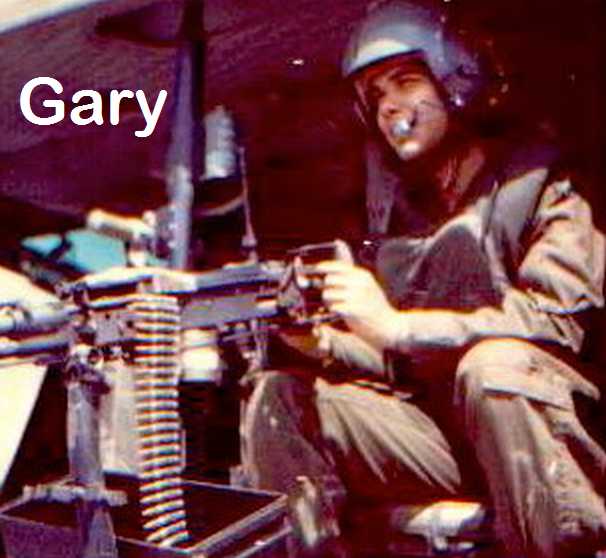 Rhodes and I were immediately aware of the many dug out fighting
positions that surrounded the LZ on its southern side, the direction in
which we were moving. Fortunately, they were empty. It did not mean,
though, that there weren’t more bad guys within reach of us, and it
seemed prudent to make small movements and then listen to determine if
we had been detected.
Rhodes and I were immediately aware of the many dug out fighting
positions that surrounded the LZ on its southern side, the direction in
which we were moving. Fortunately, they were empty. It did not mean,
though, that there weren’t more bad guys within reach of us, and it
seemed prudent to make small movements and then listen to determine if
we had been detected.
Later, we would learn that two Shark gunships were shot down when they
nosed around our ambush site. All crewmembers were successfully
extracted.
We made our way to a bomb crater about 20 to 30 feet across. Above us
was an Army O-1 spotter plane. I’m sure he was there because of our
predicament. He was flying in tight circles over our heads. I got into
the middle of the crater and tried to signal him. I have no idea if he
saw me or not, but I can distinctly remember hearing enemy rounds
hitting the skin of the Bird Dog, eventually driving him away. With no
radio, no way of telling anyone we were alive, we were listed as missing
in action on the 101st Aviation Group’s log of the day’s activities.
We went down late on the afternoon of the 3rd, a Wednesday as I recall,
and would not get out until Saturday morning, the 6th. We found a thick
clump of low, scrubby bushes that seemed to provide excellent
concealment and made that our home for the next two and half days. Time
seemed to stop, and we rotated through daylight and darkness, feeling
fairly secure when it became apparent that the bad guys were going to
leave us alone. The only excitement came when a Cobra gunship just to
the east of us fired rockets at such a high elevation that the rocket
motors burned out and detached before reaching the target and several
crashed through the brush near us
We smoked our last cigarettes, slept on and off, and prayed that it
would rain.
We had no water other than the dew that would form overnight on the
leaves of our hideout. It was just enough to keep us from becoming
parched to the point of not being able to speak.
It was thirst that finally drove us from our shelter Saturday morning.
We could hear voices to the southwest of us, and we moved in that
direction. We could see troops moving back and forth on a low ridgeline
ahead of us, but we couldn’t tell at first if they were friend or foe.
When we could make out that the troops were wearing the distinctive G.I.
steel pot, we felt safe to make our move and approached with hands
raised saying something like "G.I., don’t shoot."
They were glad to see us, and shared what water they could spare. I
approached a South Vietnamese soldier who appeared to be the radioman
and asked to use his radio. I dialed in the FM frequency we had been
using the day we went down and immediately made contact with Red Oak
Dragon. I told him who we were, and within minutes, it seems, a Dustoff
helicopter was clattering into our LZ. The ARVN commander insisted that
his dead troops in body bags be loaded first, but the Dustoff pilot
would have none of that. He had his crew chief step down and bar their
way, and we hopped aboard. Back at Khe Sanh, we had to scurry into the
first available bunker because the airfield was under rocket attack.
We soon learned about Butch and his crew going down on the 5th two days
after us. They were still on the ground in Laos but in radio contact.
Their plight made our scrape sound like an unscheduled R&R.
I’ll let Butch tell you about it in an abbreviated version of his
account that appears on the 174th web site:
We were just west of A Luoi when we were hit by .51 cal fire. At least
one round hit the engine, and it quit. I got off a MAYDAY call…I
executed a low-level crash landing into the trees, letting the tail boom
take the brunt of the crash. No one was hurt. Everyone got out without
trouble…We only had one survival radio, our individual weapons, and our
individual canteens. There was no food on the ship….
We saw some NVA coming toward us, so we moved off about 200 yards. We
knew the NVA would have no trouble finding our ship, so there was no
point in staying near it…. We came to an abandoned NVA .51 cal pit that
we thought we could defend, and we set up there….
That evening we received a pretty serious ground probe from the NVA,
that in retrospect was probably intended for us to use up our ammo. My
most vivid memory of that evening is the "pop" sound of the spoon on a
grenade flying toward us, then bouncing off the trunk of a tree in front
of us, and exploding on the other side of the tree.
Thank God for the US Air Force AC-130A "Spectre" gunships. They were
night vision equipped and would fire within 20 to 30 FEET of our
position. The NVA quickly learned that any serious threat against us was
quickly met with an air strike during daylight hours and Specter during
the night….
The USAF FAC (Forward Air Controller) reported that, at one time, he had
eight sets of bombers stacked up waiting to put their loads in around
us. Only once did they scare us. When the FAC talked to his jets, he
would have to tune his radio to their frequency and couldn't talk to us.
A Thai team put a load of CBU (cluster bomb units) in very close, and we
couldn't tell him just how close it was. Our gunner was hit in the arm
from some of the shrapnel.
BG Sid Berry flew over us that morning and said they had a plan for "one
more thing" to get us out, but after that we were on our own. Naturally,
we understood there is only so much anyone can do, but those were pretty
scary words. For security reasons he didn't tell us what they planned to
do. It involved inserting (a) Hac Bao company about a mile southeast of
us that afternoon. The Hac Bao were the Black Tiger troops of the 1st
ARVN Inf Div that would recover downed US crews in Laos.
We weren't exactly sure what was going on at first. Then we could see
what was obviously a combat insertion, and listened to almost continual
fire fights as the ARVN worked their way to us….
I don't remember sleeping at all during those three days and two nights.
We were very much aware that the Hac Bao were getting close to us. We
could talk to the FAC and he had a Vietnamese "backseater" who could
talk to the Hac Bao. We had arranged a password--we were to call out
"Witch Doctor" and they "Hac Bao." But they kept saying "A OK." We'd
tell the FAC that they were not saying the correct words and to have his
"backseater" get it right, but this never happened. It really didn't
matter much, for we only had four rounds of ammo left when they got near
us. If it hadn’t have been them, we would have had to go with whoever it
was anyway….
We linked up about 3 p.m. and moved back over the same terrain and
trails they had taken to get to us. It took us about 3 hours. We passed
concrete bunkers and some impressive NVA works. It was obvious that the
NVA had "built to stay" in this area. (The Hac Bao) were very good
troops and certainly had our respect and appreciation—they saved our
lives!
You’d have to know Butch to appreciate what he did upon landing at Khe
Sanh after being picked up on March 7th. Forthright and plainspoken,
prone to do or say the first thing that comes to mind, Butch acted on
instinct and reflected later. As they got off the helicopter at Khe
Sanh, he remembered with distinctly less equanimity what BG Berry had
said to them, that if the Hac Bau insertion did not work, no more Army
resources would be "wasted" to get them out and they would be on their
own. As Berry and General Creighton Abrams, Westmoreland’s successor as
Commander of all US forces in Vietnam, extended their hands in welcome,
Butch ignored Berry, refusing to shake his hand, and grasped Abrams’
hand in both of his.
While on the ground in Laos, Butch was promoted to captain by our new
CO, Maj. Dale Spratt the same day Berry made his statement. Butch
recalls in a private monograph he published in 1995 about his experience
that he requested over the radio that Berry be sent down to pin on his
new rank, an intended sarcasm since it was rumored that Berry never flew
below 7,500 feet. Butch retired in 1991 with the rank of major after
more than 20 years of service.
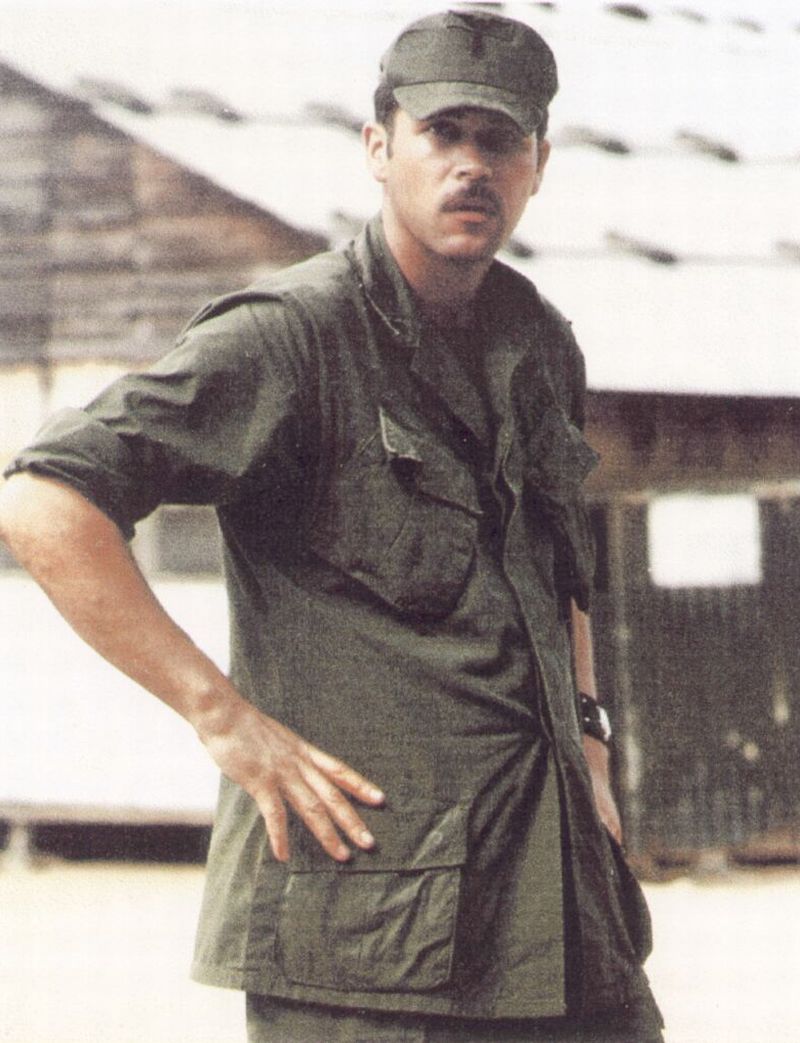 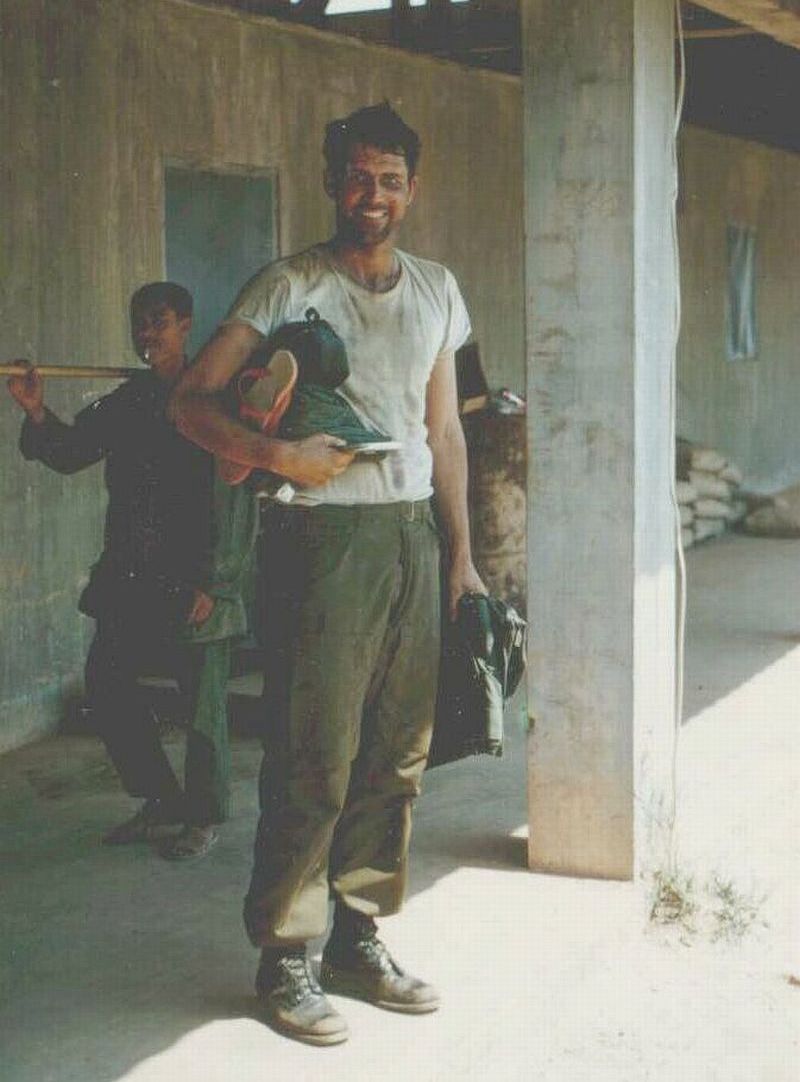
Above Left: John Bishop before "shoot down." Right: John Bishop after "recovery." Photos courtesy of "the late" Shark 7 Fred Thompson
Back in Quang Tri, after I’d showered and put on clean fatigues, I was
told that John Rich, an NBC news correspondent, wanted to interview me
about our shoot down. (photo by Fred Thompson below).
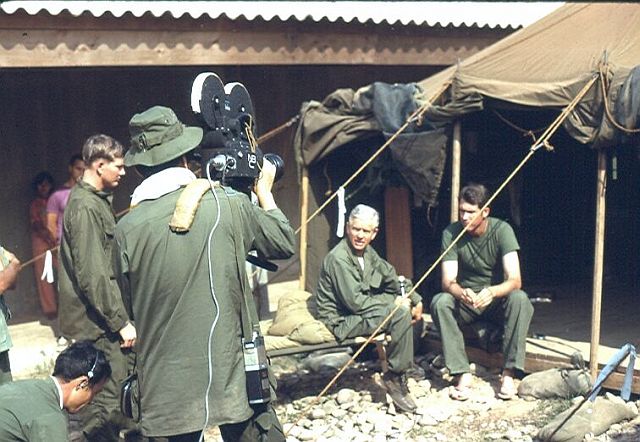
(Voice of John Chancellor, NBC News): "And it remains out of reach of
the South Vietnamese. But it was disclosed today that Laotian troops and
some irregulars are advancing on the road from the west And as our
correspondents there are learning, the part of Laos occupied by the
South Vietnamese, is still these days a very dangerous place."
(Voice of John Bishop): "This was the first lift I made into what I
assumed was the correct LZ. I had seven ARVNs on board and I don’t know
what happened to them after landing. All I remember is getting out of
the aircraft. I don’t remember seeing any of the troops or any of my
crew until I finally linked up with my crew chief and we evaded and
escaped the enemy.
The only thing we really had to subsist on was the moisture on the
leaves in the morning, the dew, that had formed and we sucked leaves and
this helped to alleviate some of the thirst.
This morning we figured, well, it doesn’t appear that anybody really
knows where we are. Of course, I didn’t have my survival radio so we
moved out this morning and were very fortunate striking on to an ARVN
unit located 700 meters further to the southwest. We linked up with them
and we coordinated Dustoff and lifted out of their LZ about 10:00 or
11:00 o’clock this morning."
(Voice of John Chancellor): "A South Vietnamese officer is quoted today
by the Associated Press as saying there now between 20 and 24,000 South
Vietnamese troops in Laos. In addition to that force, the South
Vietnamese have 23,000 troops in Cambodia which means that in South
Vietnam itself there are practically no first line South Vietnamese
troops left, only elements of one Marine division."
I never flew again after my shoot down. In about two weeks, I developed
a high fever and bone rattling chills. Malaria! Just that brief time on
the ground in Laos without the daily anti-malarial dosage was enough to
make me vulnerable to a mosquito bite.
After several days in the infirmary in Quang Tri, I was shipped south to
a hospital in Quin Nhon with a diagnosis of falciparum malaria, the
worst kind. From there, I was med-evaced through Tokyo, Japan and on to
Valley Forge Military Hospital. I spent a couple of nights there, was
discharged and went home to see my family in southeastern PA. Within
days, I was back in Savannah, and on April 5, 1971, married my wife,
Patricia. I’d been out of Vietnam about two weeks and ended my year-long
tour about a month and a half short.
What can I say about Vietnam? It was exciting. It was challenging to
become a good pilot and, ultimately, an aircraft commander. You worked
hard to build on the basics learned in flight school; you learned how to
land to a pinnacle with shifting, deceptive winds or how to nurse a weak
ship off the ground with a maximum load and high density altitude; you
learned sling loads, you flew night flare missions, you flew in bad
weather, you flew twelve- and thirteen-hour days, and, sometimes, but
not very often, you got shot at.
I remember my first combat assault in Vietnam. I was flying in flight
lead with Lt. Bill Smith, a laconic Yankee from Massachusetts. Not only
was he the flight leader but he was talking on at least three different
radio frequencies, giving instructions to our crewchief and gunner over
the intercom, maintaining order within the flight, briefing various
ground commanders, getting artillery clearance and all the while
patiently explaining to me why this and why that. I was deeply impressed
and greatly dispirited. It wasn't possible to learn how to do that in
one year. Surely, this guy was on his third consecutive tour and had
logged thousands of hours in the air doing the impossible everyday.
But you learned how and it became almost second nature. You were proud
to do your job well. With your hands on the flight controls and your
feet on the pedals, you and the helicopter became one mechanism: flesh,
blood, and bone fusing into steel control tube, life and energy
pulsating through control linkages and hydraulic lines and all of it
sheathed in an olive drab skin of magnesium alloy.
Unfortunately, good pilot technique was about all we brought with us to
Lam Son 719. None of us had flown in a truly hostile environment before,
and to make matters worse, the Army did not heed the warnings of the 7th
Air Force about the concentration of antiaircraft guns – 57-, 37-, and
23mm – and small arms in Laos. Up until that fateful day of March 3, the
US Army and the ARVN tended to "go it alone" without fully utilizing the
tactical air support available to them. They preferred to make
insertions as soon after first light as possible to give the troops
maximum time to prepare night defensive positions. Early morning cloud
cover often made it impossible for strike aircraft to provide support.
The resources at our disposal were awesome: Air Force F-4 Phantoms out
of Phu Cat, Da Nang, and Thailand; F-100 Super Sabres from Phan Rang;
Marine and Navy F-4s, A-4 Skyhawks, and A-6 Intruders; AC 119K Stinger
and AC-130A Specter gunships; B-52s out of Thailand; A-1 Skyraiders for
search and rescue; and Vietnamese Air Force assets, including
helicopters and strike aircraft.
Most of the close air support was provided by F-4s and F-100s delivering
500-pound Snakeye bombs and napalm at a low angle. Laser-guided bombs
(the precursors to today’s "smart bombs") were used effectively against
enemy gun emplacements and armor.
During daylight hours, a new pair of strike aircraft would appear on
station every 10 minutes, and six FACs flying OV-10 Broncos provided
traffic control and identified targets. Support was around the clock and
only lapsed when weather conditions prohibited it.
This mighty air arsenal, even when used to maximum effect, could not
give the ARVN the edge it needed for a successful campaign. The NVA knew
we were coming, perhaps two months in advance, and prepared accordingly.
In the dense, mountainous terrain, there were few sites suitable for
LZs. The NVA "triangulated these areas and much of the high ground with
antiaircraft weapons and preregistered their artillery and mortars to
zero in on the potential LZs." They knew the terrain and moved freely
through its dense vegetation, making them hard to spot. Weapons
emplacements were well camouflaged. It is estimated that among the
approximately 35,000 NVA troops opposed against us in Laos, there were
nineteen NVA antiaircraft battalions.
The ARVN, on the other hand, tended not to move very far from their fire
bases, which permitted the NVA to "hug" the perimeter in offensive
positions and unleash a withering barrage of small arms fire on
helicopters attempting to land or take off. Their proximity to the ARVN
made it dangerous to call in air strikes. (One ARVN commander actually
called in a strike on his position when he realized the NVA were digging
through his bunker.)
All this, of course, reduced the mobility of the ARVN troops and made it
difficult, if not impossible at times, to resupply them. Beginning on
March 18, General Lam, with President Thieu’s blessing, began
withdrawing troops from Laos almost a month and a half ahead of
schedule. As the ARVNs prepared to vacate their fire bases and move
their tanks and vehicles east along Rt. 9, the NVA began massing their
Soviet-built tanks to pounce on the retreating column. If it had not
been for tactical air support which, all told, knocked out 108 of the
estimated 120 enemy tanks, the South Vietnamese would have suffered
grave losses. Incidentally, Cobra gunships were credited with six tank
kills during Lam Son 719.
About the best that can be said of Lam Son 719 was that it probably
interrupted NVA movement enough to prevent a major offensive in South
Vietnam during the spring of 1971.
Lam Son 719 was a major effort to "Vietnamize" the war, to let ARVN
soldiers fight and die so that American soldiers could live and go home.
The South Vietnamese suffered a 50% casualty rate during Lam Son 719.
U.S. losses were 137, almost all aircrewmembers. Five strike aircraft
were shot down and 90 helicopters were lost. Fourteen of our company’s
20 UH-1H Dolphin helicopters and all six of the UH-1C Shark gunships
were lost during the operation.
The two worst days to be flying in Laos were March 3rd when eleven Hueys
were downed in the vicinity of LZ Lo Lo and March 20th when ten Hueys
were shot down attempting to extract ARVN troops from PZ Brown.
In mid-March, Newsweek had a cover story on the "helicopter war" and
didn’t tell us anything we didn’t already know but made it clear to the
outside world what a dangerous business this was.
I
don’t know anybody who went to Vietnam to win the war. Ultimately, it
was a matter of survival, of doing your time and getting back home. I
don’t remember ever having a conversation about the "rightness" or the
"wrongness" of the war while I was there. It would have made no sense.
"It don’t mean nothing" was the classic retort that minimized a serious
situation without making trivializing it. The zealots were back in
Washington or were REMFS (Rear Echelon Mother F**kers) who got no closer
to actual combat than falling down drunk in the Officers’ Club. Zeal
under fire would probably get you killed.
The war, after all, was unwinnable. Before the end of the dry season
that May, enemy truck traffic within Laos reached a peak for the year,
surpassing that for a similar period one year before. Nothing we did
seemed to make a difference in the North Vietnamese will to fight on.
What we failed to realize was that they were the only ones fighting for
something they believed in: the reunification of Vietnam under their
control.
Our involvement in Vietnam went back to the end of WW II when we helped
restore the French to colonial rule in Indochina. Sadly, we learned
nothing from the French experience. By the time Dien Bien Phu fell in
1954, we were subsidizing 80% of the French war effort. Entreaties to
avoid getting involved in a land war in Asia were falling on deaf ears.
Cold War hysteria, beginning with the fall of China to Communism in 1949
and followed quickly by Russia’s successful explosion of an atomic bomb,
reached a giddy level of paranoia with Senator Joseph McCarthy’s
Communist witch hunt in the early 1950s. The coldest warrior of them
all, John Foster Dulles, beat the drum at the State Department long and
loud enough until it was accepted as fact that Communism was a unified,
worldwide conspiracy, and that Asian dominoes were to be propped up at
all costs.
Our inevitable intervention in Vietnam with the introduction of US Army
advisors in 1955 began as a matter of national security. Kennedy
inherited Eisenhower’s commitment but seemed ambivalent about how far we
should be drawn in. Had he lived, he may have de-escalated the
commitment after the 1964 election, but that’s merely speculation. Under
Johnson and Nixon, it became a matter of national prestige to continue a
war that was becoming increasingly unpopular, and, after the Tet
Offensive in 1968, clearly beyond our ability to bring to a successful
conclusion. The mantra now became "Peace with honor", a Nixonian conceit
for saving national face or, more likely, his own.
Having ignored or spurned numerous attempts by allies to broker a
negotiated settlement to the war, we finally sold out our South
Vietnamese allies in 1973 in Paris with a treaty that differed little on
paper from the Geneva settlement of 1954. In other words, "the new
political order was approximately what it would have been if America had
never intervened" to quote Barbara Tuchman in her essay "America Betrays
Herself in Vietnam" from her 1984 book The March of Folly.
If any shame attaches to our involvement, it may be in the fact that the
burden of fighting and dying fell disproportionately on draftees who had
no choice about it. Young men with deferments could listen to Country
Joe and the Fish sing the "I-Feel-Like-I’m-Fixin’-To-Die-Rag" and
appreciate the irony in the lyric "…put down your books, pick up a gun,
we’re gonna have a whole lot of fun." They held tightly to their books.
The inequity was not lost on the less privileged whose own anthems
ranged from the urgency of the Animals’ "We Gotta Get Out of This Place"
to the unambiguous cynicism of Creedence Clearwater Revival’s
"Fortunate Son": "…It ain’t me, it ain’t me, I ain’t no senator’s
son."
I had a choice, but I chose to go. I have no regrets about serving in
Vietnam. It has proved to be neither an advantage nor a disadvantage.
There are no nightmares, no physical or psychic wounds. There has been a
kind of closure to the whole thing. I have seen some of the men with
whom I served on two occasions during annual reunions of the Vietnam
Helicopter Pilots Association: in Ft. Worth in 1988 and in Atlanta in
1992. Those reunions were opportunities to observe that most of us
picked up and moved on with our lives.
Vietnam: it was just something we did once upon a time.
I would like to acknowledge the help of Mike Sloniker, the Historian of
the 174th web site, who provided me with a number of fascinating
documents, some previously classified, that gave me a greater
understanding and appreciation of the scope of Lam Son 719. Mike joined
the 174th in Vietnam in July 1971 after I had left so our paths did not
cross there.
I’d also like to recognize Fred Thompson. Fred and I served together.
Fred was a Shark gunship pilot during Lam Son 719 and was shot in the
head on February 24, 1971 while on a mission in Laos. Fred’s efforts to
locate former members of the 174th have been singular and untiring. Fred
provided me with the audiocassette with Butch Elliott’s "Mayday." It’s
an amazing record of much of the action of March 5, 1971 and gives me
chills every time I listen to it.
Thanks, Fred and thanks, Mike.
|
 Click here
Click here  to e-mail us at the website
to e-mail us at the website 
![]() Return to top of: 1971 History Page.
Return to top of: 1971 History Page.![]() Return to top of: Home Page.
Return to top of: Home Page.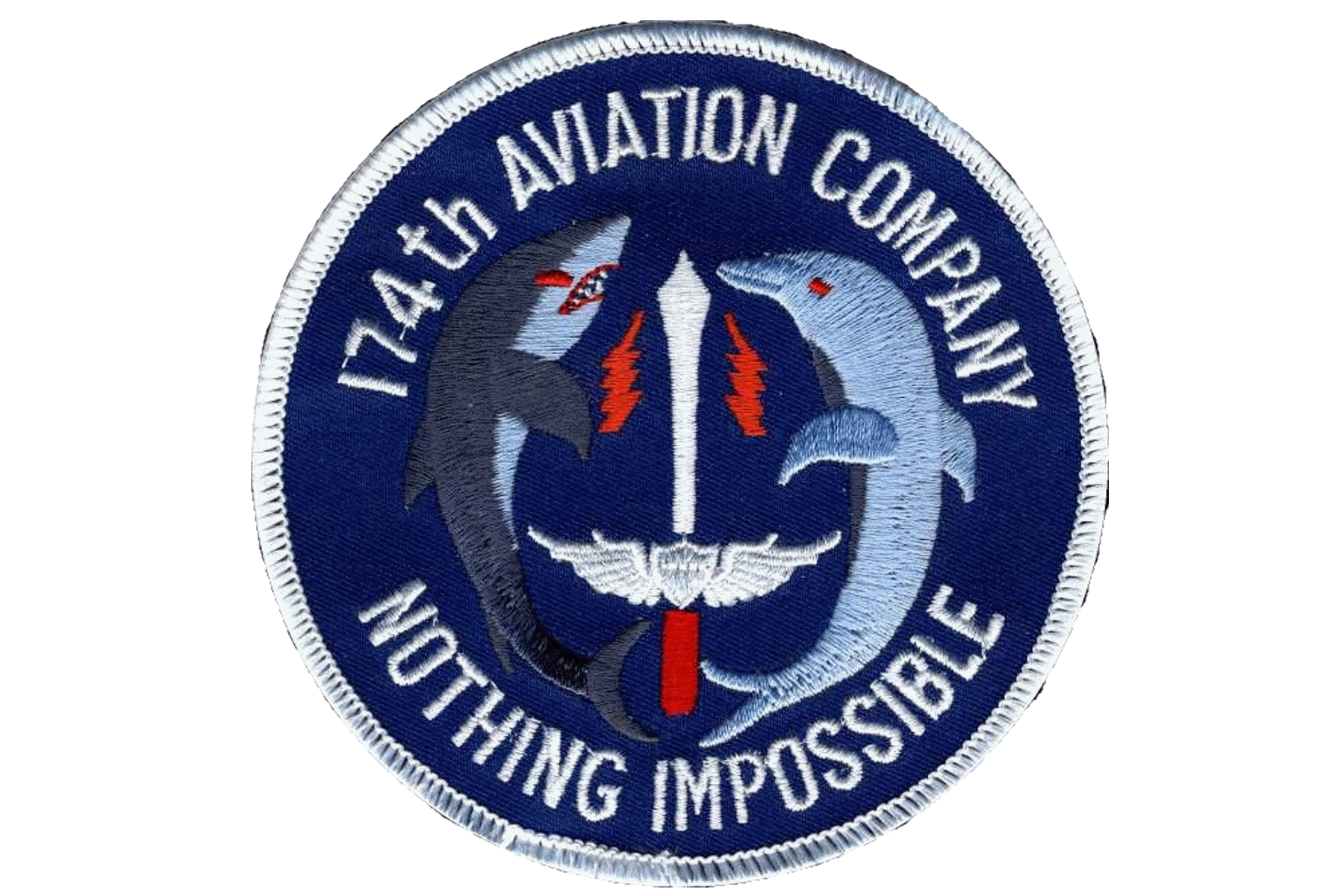
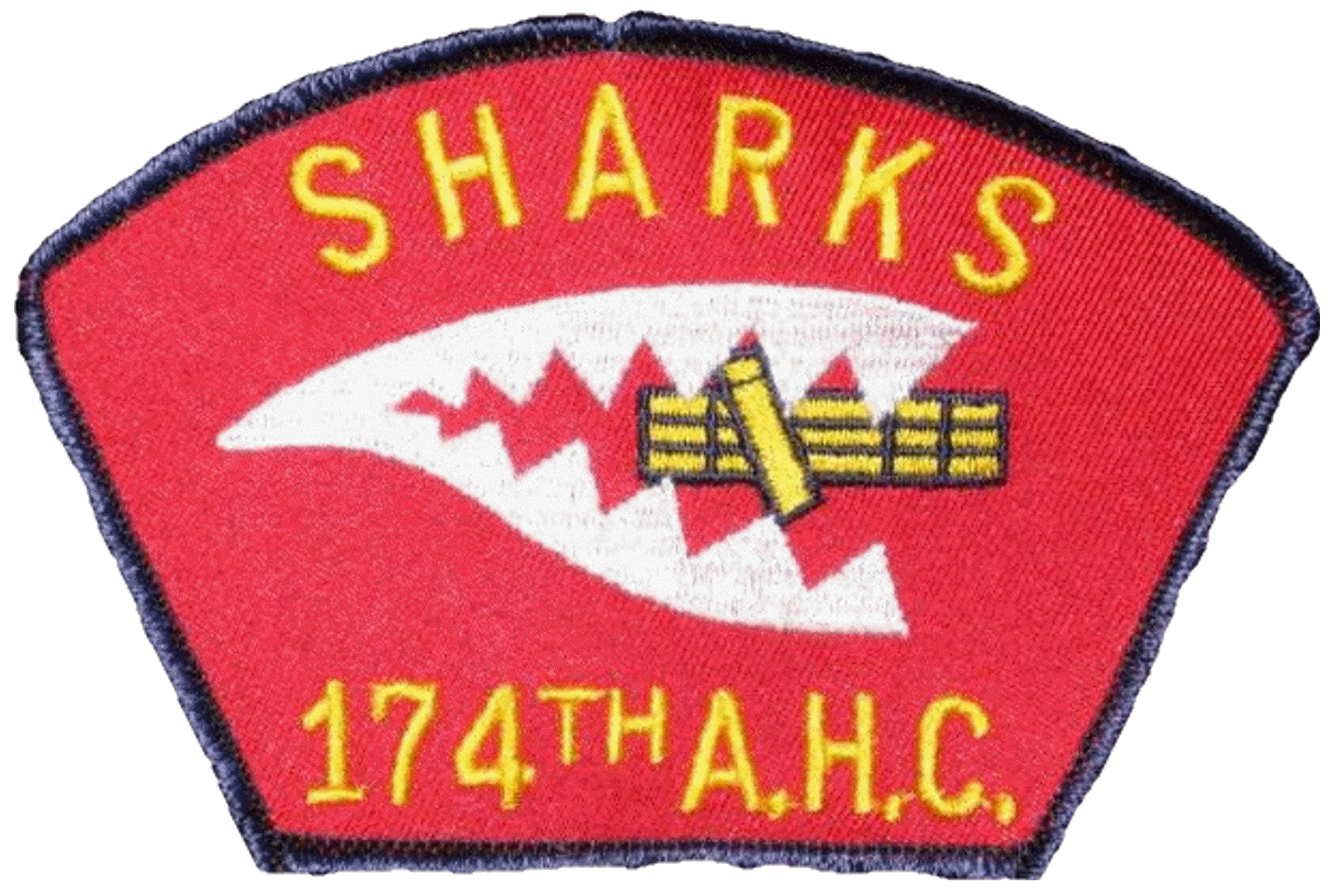
 Rhodes and I were immediately aware of the many dug out fighting
positions that surrounded the LZ on its southern side, the direction in
which we were moving. Fortunately, they were empty. It did not mean,
though, that there weren’t more bad guys within reach of us, and it
seemed prudent to make small movements and then listen to determine if
we had been detected.
Rhodes and I were immediately aware of the many dug out fighting
positions that surrounded the LZ on its southern side, the direction in
which we were moving. Fortunately, they were empty. It did not mean,
though, that there weren’t more bad guys within reach of us, and it
seemed prudent to make small movements and then listen to determine if
we had been detected.

